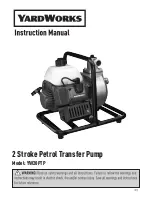
6
2.2 Installation
Transport
To protect the equipment against
damage, it must be transported vertically
inside its dedicated packaging. Where
space is restricted, you may also briefly
move the equipment tipped backwards at
an angle.
Positioning
—
Position the device in the installation
location.
Note: Ensure that the casing
panel in the lower area of
the device is not damaged during
positioning.
—
Remove packing straps and
polystyrene mouldings.
—
Level the device by adjusting the
equipment feet.
—
After leveling the device fix the nut of
the rubber feet to provide a maximum
of structural safety.
External installation
The location where the WWK is to be
installed must meet the following
conditions:
—
Load-bearing floor (wet weight of the
WWK approx. 430 kg).
—
Never operate the WWK in rooms at a
risk from explosion due to dust, gases
or vapours.
—
It is prefferred that the location of
the unit is not near a bedroom or
a neighbour´s bedroom. Ideally a
unit may mounted near a kitchen
or laundry. Opposite a neighbours
garage is always prefferred.
—
The water heater should be located
as close as possible to the most
frequently used hot water tap
connection.
—
Ensure that the data plate is clearly
visible.
—
Ensure that the ambient temperature
lies within the application limits for
heat pump operation.
Internal installation
The room where the WWK is to be
installed must meet the following
conditions:
—
Load-bearing floor (wet weight of the
WWK approx. 430 kg).
—
Never operate the WWK in rooms at a
risk from explosion due to dust, gases
or vapours.
—
Include in your considerations the
utilisation of waste heat, for example
from a boiler, tumble drier or
refrigerator/freezer.
—
The available floor area in the
installation room must be at least
6 m². Never install this equipment
in rooms with a volume of
less than
13 m³.
—
Never restrict the clearances of the
WWK through walls and ceilings
further than illustrated in Fig. 2.
—
The room temperature must never fall
below 0 °C, as the ambient tempera-
ture will be reduced by approx. 1-3 °C
through the heat pump operation. The
initial temperature is reached again
approx. ½ h after the heat pump has
been switched OFF.
When installing the heat pump in a boiler
room, ensure that the boiler operation
will not be impaired.
2.3 Water connection
—
Remove the protective caps from the
connectors.
—
With a sharp knife, cut a hole into the
protective caps and invert over the
pipe to be connected.
—
Connect the pipe and refit the
protective caps.
!
Please note: To protect against
the risk of corrosion, make the
connection as flat packing seal. The
use of hemp on connections is not
acceptable.
Air
Air
Dimensions in mm
26
�03
�01
�1619
�
3
1
2
1 Condensate drain
2 Hot water connection
3 Condensate spillover
Insulate the DHW line in accordance with
local regulations.
Accurately maintain the order of fittings
on the cold water side (see Fig. 1).
Flush the line prior to installation.
Install a drain valve at the lowest point
of the cold water supply inlet for future
maintenance of the tank.
Install a 700 kPa pressure and tempera-
ture relief valve (PTRV) (Fig. 1, pos. 4).
Observe the requirements for expansion
control valve (ECV) (Fig. 1, pos. 7). In such
case, use a 550 kPa valve.
A pressure reduction valve (PRV) must
be fitted (Fig. 1, pos 12) and adjusted to
a maximum of 500 kPa. If the ECV is re-
quired, set PRV to a maximum of 420 kPa.
Please observe the following:
—
Supply and drain pipe sizes should be
equal to safety valve sizes.
—
Size the drain so that water can drain
off, even if the safety valve has been
fully opened.
—
The drain outlet must not be able to
be closed and must always remain
open to atmosphere.
Fig. 2
Positioning
26
�03
�01
�1618
≥ 400
≥ 400
≥ 400
≥ 100
670
280010-36039-8627 WWK 300 AHP en_AU.indb 6
24.01.2011 13:36:42
Summary of Contents for WWK 300 A
Page 1: ...Operation and installation DHW heat pump WWK 300 A WWK 300 AP WWK 300 AH WWK 300 AHP ...
Page 17: ...17 ...
Page 18: ...18 ...
Page 19: ...19 ...






































